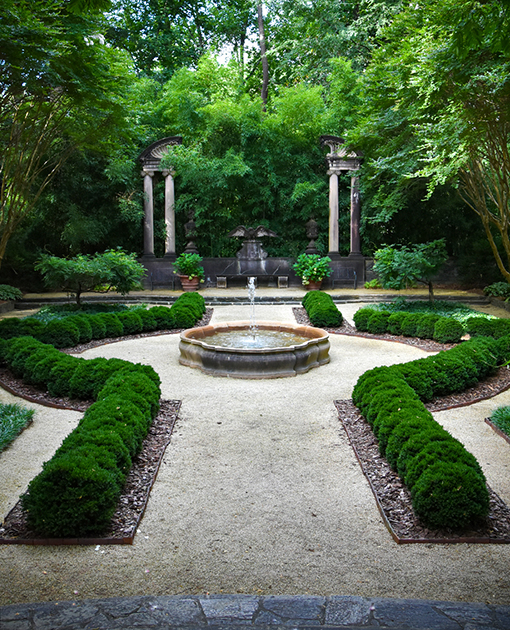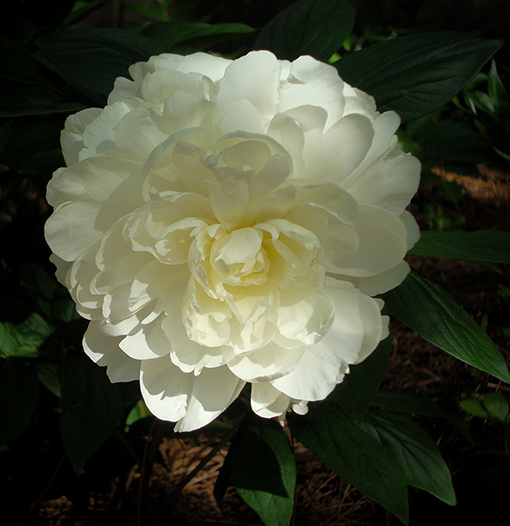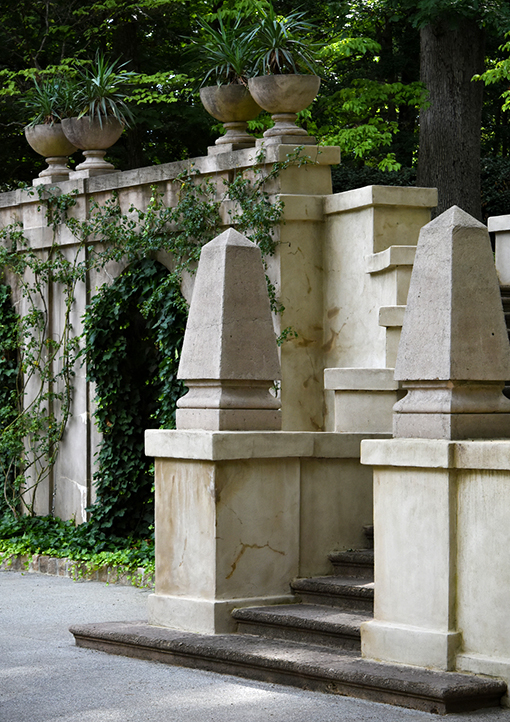The home was acquired by the Atlanta History Center in the mid 1960s and opened to the public in 1967, a delight to locals and visitors from around the world since.
 |
| Swan House Gardens | Atlanta History Center | Photo: Travis Swann Taylor |
While the Inman family lost much of its wealth during the US Civil War, Edward Hamilton Inman (1881-1931) inherited a large cotton brokerage fortune. His interests included real estate, transportation, banking, and politics. He served on the City Council and at one point ran for mayor. He married Emily Caroline McDougal (1881- 1965) whose interests included philanthropy, politics, and society. The effects of their philanthropy continues to abound in Atlanta.
The Inman's built Swan House, completed in 1928, for more than $100,000 at a time when the average cost of a new home was $2,000, so you can imagine its splendor, which includes its acres of magnificent gardens.
The cascading fountain at the front of the house was designed after a similar one at Villa Corsini in Italy. Atop the attic cornice are two allegorical statues of "Spring" and "Autumn", the seasons during which Swan House Gardens are most spectacular. Their epic "front yard" is comprised of multiple tiers of gorgeous green grass, retaining walls, and fountains. Swan House is one of the most photographed structures in Atlanta.
The open arm stairway leading the the front door of Swan House is embellished with yellow Lady Banks Roses, a pop of complimentary color to the round-arched wall niches flanking the doorway, each inset with a shell motif and colored with sienna stucco. Lady Banks Roses are named for the wife of Sir Joseph Banks, renowned botanist and director of the Royal Botanic Gardens at Kew in southwest London along the River Thames.
Philip Trammell Shutze, still considered one of Atlanta's greatest architects, designed Swan House and Swan House Gardens. Sometimes, when Swan House is open for tours, you may have the opportunity to meet Shutze! The home will often host costumed, first-person interpreters who delightfully enhance visitors' experience of Swan House.
The exquisite Boxwood Garden is at the north side of the house. Immediately behind me (when taking this photo) is the Screened-In Porch, often open for visitors to enjoy. Some of you may recall this space as the Breakfast Room in President Snow's (Donald Sutherland) mansion in 2013's The Hunger Games: Catching Fire. He enjoyed breakfast with is granddaughter who was wearing her hair in the style of heroine Katniss Everdeen.
The paired columns atop a broken pediment framing a garden bench and a majestic eagle are located in the Boxwood Garden at the southern side of the house. This site is today used for many private events including fundraisers, corporate parties, and wedding receptions.
This garden has also seen its day in the Hollywood spotlight. It was the site of the evening party at the Capitol in The Hunger Games: Catching Fire., starring Jennifer Lawrence (Katniss Everdeen) and Josh Hutcherson (Peter Mellark). Also in the film were the Swan House lawn and the front of Swan House.
These beauties are planted near or in the Boxwood Garden at the north end of Swan House. While white flowers are beautiful in any garden, as are these, I personally couldn't help but be reminded of President Snow's signature white rose when I saw these, given their proximity to the numerous scenes from The Hunger Games: Catching Fire when Snow was seen with said white rose.
From this vista, you can see the back of Swan House (where the public enters the house), through the Boxwood Garden, all the way to Ambrose the elephant in Swan Woods, which extend all the way to the front of the expansive Swan House lawn.
There's ample statuary throughout Swan House Gardens, scattered thoughtfully and sparingly. To the left of the pair of duos here, at the south corner of Swan House, is a Victorian Playhouse! That playhouse, which grownups can fit inside, was built in downtown Atlanta in 1890. After several moves in Atlanta, it was donated to the Atlanta History Center by the William D. Ellis family in 1980.
Pink Dogwood Trees, filled with its namesake blossoms in spring, grow on the north side of the house, visible from the Dining Room and Breakfast Porch of Swan House, the latter not accessible to the public. If approaching Swan House from the bridge over the Quarry Garden, these beauties are one of the first things you'll see in Swan House Gardens in the spring. Many of the gardens here offer a delightful sense of tranquility.
Today's visitors, as did visitors in the late 1920s, entered through the back of the house, which a first-time visitor may mistake for the front of the house because of its grandeur. Even the garden on the opposite side of the driveway (pictured above) is splendid!
You may see a car or two in the driveway at the back entrance. Edward H. Inman was, among many other things, a car enthusiast. In fact, he held a number of racing records, when car racing was extremely dangerous! Not that it's not today, but there were considerably fewer safety features in race cars back then.
I don't know the provenance of this particular piece, perched in the garden overlooking the driveway at the back of Swan House, but I do know that it was relocated from the Sims Asian Garden. I think it's perfectly suited for this particular spot! I did not notice when I took the photo, but look closely...you'll see that the flower water spouts at the base are working!
Emily lived in Swan House until her passing 1965 at the age of 84. In 1966, the Atlanta History Center (then the Atlanta Historical Society) purchased the home and most of its original fabulous furnishings, ranging from 18th-century antiques to 20th-century objects. It opened to the public in 1967 as a house museum and the headquarters of the Center. Said HQ offices are today located in the museum building.
I thought that it wasn't after Emily's death that the house was bestowed the name "Swan House", a nod to the numerous instances of swans in the house's interior decor, but a April 1936 article in The Atlanta Constitution that noted "...Inman's Swan House set in a 45-acre woodland".
I've always loved visiting the Swan House and its gardens, not just because its name is so close to my middle name, Swann, but because of its magnificence, in design, architecture, and interiors.
In 2004, the Atlanta History Center completed a $5,400,000 restoration of Swan House and its furnishings. It is listed on the National Register of Historic Places. The Swan House Gardens are enjoyed by visitors and locals alike, throughout the year!
The Other Gardens: This is the sixth post in a series sharing the beauty of the nine gardens on the Atlanta History Center's 33-acre campus. You can find them all here.










No comments:
Post a Comment